São Tomé und Príncipe |
|
|
|
| Übersicht – Contents: | |
São Tomé und Príncipe |
|
|
|
| Übersicht – Contents: | |
Flagge – Flag: |
|
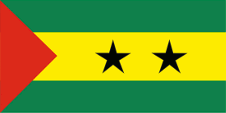 |
Nationalflagge – national flag, Seitenverhältnis – ratio = 1:2, Quelle/Source, nach/by: Flags of the World   |
historische Flaggen – historical Flags: |
|
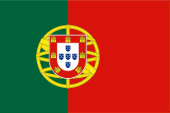 |
1911–1975, Nationalflagge Portugals – national flag of Portugal, Seitenverhältnis – ratio = 2:3, Quelle/Source, nach/by: Corel Draw 4  |
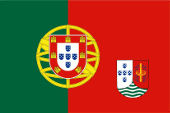 |
60-er Jahre 19. Jhd. / sixties of the 19th cent., geplante Flagge für São Tomé und Príncipe – purposed flag for São Tomé e Príncipe, Quelle/Source, nach/by: Wikipedia (DE) |
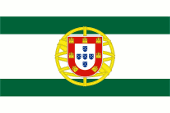 |
bis/to 1935, Flagge eines Oberkommissars – flag of a High Commissioner, Seitenverhältnis – ratio = 2:3, Quelle/Source, nach/by: Flaggenbuch 1939 |
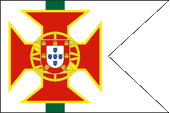 |
1935–1961, Flagge eines Distriktskommandanten – flag of a District Commandant, Seitenverhältnis – ratio = 2:3, Quelle/Source, nach/by: Flaggenbuch 1939 |
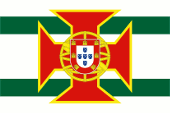 |
1935–1975, Flagge des Generalgouverneurs – flag of the Governor General, Seitenverhältnis – ratio = 2:3 Quelle/Source, nach/by: Die Welt im bunten Flaggenbild  |
| Die
Flagge von São Tomé und Príncipe wurde am 05.11.1975 eingeführt. Sie zeigt
drei waagerechte Streifen in Grün, Gelb und Grün im Verhältnis 4:6:4, sowie
ein gleichschenkliges rotes Dreieck am Liek. Im gelben mittleren Streifen
befinden sich zwei schwarze fünfstrahlige Sterne. Sie stehen für die
afrikanische Bevölkerung und die zwei Inseln, aus denen der Staat besteht. Grün repräsentiert Vegetation und Landwirtschaft, Gelb steht für die Kakaobohne (Kakao ist ein wichtiges Exportprodukt des Landes). Rot steht für das im Freiheitskampf vergossene Blut. Die Flagge und ihre Farben sind im Artikel 13 "Nationale Symbole" der Verfassung der Demokratischen Republik São Tomé und Príncipe, genehmigt im März 1990 und in Kraft getreten am 10. September 1990 beschrieben, jedoch nur als Rot, Grün, Gelb und Schwarz, ohne die Farbtöne genauer anzugeben. |
The flag
of São Tomé and Príncipe was introduced on 5th of November 1975. It shows
three horizontal stripes in green, yellow and green in a ratio of 4:6:4, as
well as an isosceles red triangle at the leech. In the yellow middle stripe are placed two black five-pointed stars. They stand for the African people and the two islands which the state consists in. Green represents vegetation and agriculture, yellow stands for the cacao bean (cacao is an important export product of the country). Red stands for the in the struggle for freedom given blood. The flag and its colours are described in Article 13 "National Symbols" of the Constitution of the Democratic Republic of São Tomé and Príncipe, approved in March 1990 and entered into force on 10th of September in 1990, but only as red, green, yellow and black, without specifying the colour shades. |
| Die Flagge von São Tomé und Príncipe geht auf die frühere Flagge der MLSTP-Partei (Movimento de Libertação de São Tomé e Príncipe) zurück, jedoch waren die drei Streifen in der Parteiflagge gleich breit. Die MLSTP entstand 1960 im Exil und benutzte diese Flagge bis 1990. Vorbild war die Flagge von Ghana, das bereits 1957 unabhängig geworden war. | The flag
of São Tomé and Príncipe has its roots in the former flag of the MLSTP-Party
(Movimento de Libertação de São Tomé e Príncipe), but the three stripes in
the party-flag had the same breadth. The MLSTP was formed in 1960 in exile
and used this flag to 1990. Model was the flag of Ghana which became
independent already in 1957. |
| Quelle/Source: Flags of the World, Wikipedia (EN), Die Welt der Flaggen, Flaggen Wappen Hymnen, Volker Preuß | |
Wappen – Coat of Arms: |
|
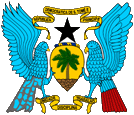 |
seit/since 1977, Wappen von São Tomé und Príncipe – Coat of arms of São Tomé and Príncipe, Quelle/Source, nach/by: Corel Draw 4 |
| Das Staatswappen von São Tomé und Príncipe wurde 1977 eingeführt und zeigt ein goldenes mandelförmiges Schild mit einem naturfarbenen Kakaobaum. Zwei blaue Papageien sind Schildhalter. Sie symbolisieren die beiden Inseln. Über dem Schild ein schwarzer Stern (manchmal merkwürdigerweise auch in Blau dargestellt), er symbolisiert die Einheit des Landes, gilt aber auch als "Leitstern der afrikanischen Freiheit". Oberhalb und unterhalb des Schildes je ein goldenes Spruchband mit Inschriften in portugiesischer Sprache. Oben der Staatsname: "Republica Democrática de S. Tomé e Príncipe", unten das Motto des Landes: "Unidade, Disciplina, Trabalho" → "Einheit, Disziplin, Arbeit". | The coat
of arms of São Tomé and Príncipe was introduced in 1977 and shows a golden
almond shaped shield with a ecru cacao tree. Two blue parrots are supporters
of the shield. They symbolize the both islands. Above the shield a black
star (sometimes oddly coloured in blue), it symbolizes the unity of the
country, but counts also as "Guiding Star of the African Freedom". Above and below the shield per one golden banner with inscriptions in Portugese language. Above the name of the state: "Republica Democrática de S. Tomé e Príncipe", below the motto of the state: "Unidade, Disciplina, Trabalho" → "Unity, Discipline, Work ". |
| Quelle/Source: Wikipedia (DE), Die Welt der Flaggen, Flaggen Wappen Hymnen, Flaggen und Wappen der Welt, Volker Preuß | |
Landkarte – Map: |
Lage – Position: |
Landkarte des Landes – Map of the Country: |
|
|
| Zahlen und Fakten – Numbers and Facts: | |
|
|
|
|
|
|
|
|
|
|
|
|
|
|
|
|
|
|
|
21.12.1470 · Entdeckung der Insel São Tomé durch die portugiesischen
Seefahrer João de Santarém und Pedro Escobar, Inbesitznahme für Portugal 14.01.1471 · Entdeckung der Insel Santo António (Príncipe) 1485 · erste portugiesische Siedlungen auf den Inseln (Sträflinge, Juden), in den Folgejahren – bis ins 18. Jahrhundert hinein – sind die Inseln ein Zentrum des Sklavenhandels, vor allem für den brasilianischen Markt, zusätzliche Besiedlung durch Sklaven und auch entlaufene Sklaven 1500 · Gründung der Stadt São Tomé 1502 · Umbenennung der Insel Santo António in "Príncipe" 1485 · die Insel São Tomé wird portugiesische Kolonie 1502 · die Insel Príncipe wird portugiesische Kolonie 1522 · die Insel São Tomé wird portugiesische Kronkolonie 1558 · die Insel Príncipe wird portugiesische Kronkolonie 1599 · São Tomé ist kurzzeitig niederländisch besetzt 16. Jahrhundert · die Inseln sind der größte Zuckerlieferant der Welt 1641–1644 · São Tomé ist niederländisch besetzt 1709–1710 · São Tomé ist französisch besetzt 1753 · die Verwaltung der Inseln São Tomé und Príncipe wird zusammengelegt 19. Jahrhundert · auf den Inseln werden Kakao und Kaffee in Plantagenwirtschaft angebaut 1869 · in den portugiesischen Kolonien wird die Sklaverei abgeschafft 1877 · Vertragsarbeiter aus Afrika übernehmnen die Arbeit der Sklaven 1913 · die Inseln sind der größte Kakaolieferant der Welt 11.06.1951 · São Tomé und Príncipe werden portugiesische Überseeprovinz 1953 · Unruhen 1960 · Gründung der Comissao de Libertacao de São Tomé e Príncipe (CLSTP) im Exil 1972 · Umbenennung der CLSTP in MLSTP (Movimento de Liberacao de São Tomé e Príncipe) 1972 · Portugal gewährt eingeschränkte Selbstverwaltung 1973 · erste Parlamentswahlen 21.12.1974 · Autonomie 12.07.1975 · Unabhängigkeit, Etablierung des Ein-Parteien-Sytems (der MLSTP) 1978 · Schutzvertrag mit Angola 1990 · neue Verfassung, Einführung des Mehrparteiensystems 1995 · Autonomieregelungen für die Insel Príncipe 15.08.1995 · Militärputsch, Rückkehr zur Demokratie 16.07.2003 · Militärputsch, Rückkehr zur Demokratie, Verfassungsänderungen 2022 · Putschversuch |
| 21st of
December 1470 · discovery of São Tomé Island by the Portugese seafarers João
de Santarém and Pedro Escobar, appropriation for Portugal 14th of January 1471 · discovery of Santo António Island (Príncipe) 1485 · first Portugese smallholdings on the islands (convicts, jews), in the afteryears – until the 18th century – the islands are a centre of the slave-trading, especially for the Brazilian market, further settlement by slaves and also escaped slaves 1500 · foundation of the City of São Tomé 1502 · rename of Santo António Island in "Príncipe" 1485 · São Tomé Island becomes a Portugese colony 1502 · Príncipe Island becomes a Portugese colony 1522 · São Tomé Island becomes a Portugese crown colony 1558 · Príncipe Island becomes a Portugese crown colony 1599 · São Tomé is momentary Dutch occupied 16th century · the islands are the bigest sugar-purveyor of the world 1641–1644 · São Tomé is Dutch occupied 1709–1710 · São Tomé is French occupied 1753 · the administration of the islands São Tomé and Príncipe becomes merged 19th century · on the islands are cultivated cacao and coffee in plantations 1869 · the slavery becomes abolished in the Portugese colonies 1877 · contract workers from Africa take over the work of the slaves 1913 · the islands are the bigest cacao-purveyor of the world 11th of June 1951 · São Tomé and Príncipe become a Portugese overseas province 1953 · riots 1960 · establishment of the Comissao de Libertacao de São Tomé e Príncipe (CLSTP) in exile 1972 · rename of the CLSTP in MLSTP (Movimento de Liberacao de São Tomé e Príncipe) 1972 · Portugal grants limited self-rule 1973 · first elections for a parliament 21st of December 1974 · autonomy 12th of July 1975 · independence, establishment of the one-party-sytem (of the MLSTP) 1978 · protection treaty with Angola 1990 · new constitution, introduction of the multi-party-sytem 1995 · autonomy adjustments for Príncipe Island 15th of August 1995 · military coup d’état, return to democracy 16th of July 2003 · military coup d’état, return to democracy, changes in constitution 2022 · attempted coup d’état |
| Quelle/Source: Atlas zur Geschichte, World Statesmen, Wikipedia (D) |
| Die Insel São Tomé verdankt ihren Namen dem Tag ihrer Entdeckung, dem 21.12.1470, dem Tag des Heiligen Thomas. Bei Príncipe war es zunächst ähnlich, denn die Insel wurde am 14.01.1471 entdeckt, dem Tag des Heiligen Anton, und die Insel hieß zunächst Santo António, wurde jedoch im Jahre 1502 zu Ehren Königs Alfons V. in "Príncipe" – Prinzeninsel oder auch Fürsteninsel – umbenannt. | São Tomé Island owes its name the day of its discovery – the 21st of December 1470 – the day of the Saint Thomas. With Príncipe it was initially the same procedure, because the island was discovered on 14th of January 1471 – the day of the Saint Anthony – and the name of the island was initially Santo António, but it was in 1502 renamed in "Príncipe" – Prince's Island – to honor King Alfons V. |
| Quelle/Source: Wikipedia (D), Volker Preuß | |